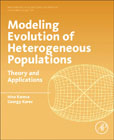
Modeling Evolution of Heterogenous Populations: Theory and Applications
Kareva, Irina
Karev, Georgy
Natural selection and evolution cannot act on any population that is not genetically heterogeneous. However, in a vast majority of conceptual, and often even descriptive mathematical models of population dynamics, whether it be predator-prey type models, spread of infectious diseases, or tumour growth, population homogeneity is the first assumption that is made. It is not regarded as homogeneity per se - rather, one assumes that an average approximation of rate of growth or infectiousness is sufficient is a reasonable enough assumption if the system has already reached some kind of a stable state. However, by ignoring population heterogeneity, or assuming that it has already done its work?, one loses the dynamics that may be driving most systems that are of interest and importance. Partially, the assumption of homogeneity is necessary to make systems manageable and available for analysis, since including assumptions about heterogeneity can increase system dimensionality to unmanageable levels. This in summary impacts the results that can be achieved. This book seeks to address this gap, helping biological scientists model the evolution of heterogenous populations and visualize evolutionary trajectories. Includes an introductory primer on mathematical modeling with ordinary differential equations for biological systemsProvides worked examples of applications to various systems of differential equationsHelps interpret results and model modifications that can be translated to readers' areas of interest INDICE: 1. Introduction. Mathematical modeling of evolution of heterogeneous populations 2. Hidden keystone variables method and models of Malthusian type 3. Selection systems and the Reduction theorem 4. Inhomogeneous population models 5. Inhomogeneous logistic equations and non-Darwinian evolution 6. Discrete time selection system 7. Replicator dynamics and the Principle of minimum of information gain 8. Inhomogeneous models of population extinction 9. What can we learn from growth curves 10. Inhomogeneous models of communities 11. Applications to ecological problems 12. Natural selection of strategies. Allocation of resources in biological systems 13. Evolutionary game theory
- ISBN: 978-0-12-814368-1
- Editorial: Academic Press
- Encuadernacion: Rústica
- Páginas: 300
- Fecha Publicación: 01/09/2019
- Nº Volúmenes: 1
- Idioma: Inglés
